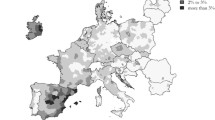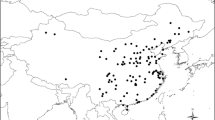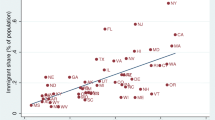Abstract
The role of population size in environmental degradation is a source of both political and academic debate, with the role of immigrant population being particularly salient in developed countries such as the USA. We test the relationship between two population specifications and air quality in the US context, using spatial panel analysis of the Environmental Protection Agency’s Air Quality Index, population, and other explanatory variables for contiguous US counties from 2007 to 2014. We find that both population in general and immigrant population in particular are associated with better, rather than worse air quality. These results are in line with political economy theories arguing that population is not the root cause of environmental problems and coincide with empirical findings of ecologically unequal exchange between core and peripheral countries.

Similar content being viewed by others
References
Allison, P. D. (2012a). Missing data. Thousand Oaks, CA: Sage.
Allison, P. D. (2012b). Why you probably need more imputations than you think. Statistical Horizons. Available at http://statisticalhorizons.com/more-imputationsal. Cited 14 May 2018.
Angus, I., & Butler, S. (2011). Too many people? Population, immigration, and the environmental crisis. Haymarket Books.
Anselin, L. (1988). Spatial econometrics: methods and models. Dorddrecht: Kluwer Academic Publishers.
Atiles, J. H., & Bohon, S. A. (2003). Camas calientes: housing adjustments and barriers to social and economic adaptation among Georgia’s rural Latinos. Southern Rural Sociology, 19(1), 97–122.
Beck, R. (1996). The case against immigration: the moral, economic, social, and environmental reasons for reducing immigration back to traditional levels. New York: WW Norton & Company.
Blumenberg, E., & Shiki, K. (2008). Immigrants and resource sharing: the case of carpooling. Transportation Research Board 87th Annual Meeting, 22.
Bodner, T. E. (2008). What improves with increased missing data imputations? Structural Equation Modeling, 15(4), 651–675.
Bohon, S. A., Stamps, K., & Atiles, J. H. (2008). Transportation and migrant adjustment in Georgia. Population Research and Policy Review, 27(3), 273–291.
Bunker, S. G. (1984). Modes of extraction, unequal exchange, and the progressive underdevelopment of an extreme periphery: the Brazilian Amazon, 1600-1980. The American Journal of Sociology, 89(5), 1017–1064.
Cafaro, P. (2015). How many is too many? The progressive argument for reducing immigration into the United States. Chicago, IL: University of Chicago Press.
Carter, E. D., Silva, B., & Guzmán, G. (2013). Migration, acculturation, and environmental values: the case of Mexican immigrants in central Iowa. Annals of the Association of American Geographers, 103(1), 129–147.
Chapman, R. L. (2006). Confessions of a Malthusian restrictionist. Ecological Economics, 59(2), 214–219.
Chatman, D. G., & Klein, N. (2009). Immigrants and travel demand in the United States: implications for transportation policy and future research. Public Works Management & Policy, 13(4), 312–327.
Chen, X., Shao, S., Tian, Z., Xie, Z., & Yin, P. (2017). Impacts of air pollution and its spatial spillover effect on public health based on China’s big data sample. Journal of Cleaner Production, 142, 915–925.
Ciplet, D., Roberts, T., & Khan, M. (2015). Power in a warming world: the new global politics of climate change and the remaking of environmental inequality. Cambridge, MA: MIT Press.
Clement, M. T., & York, R. (2017). The asymmetric environmental consequences of population change: an exploratory county-level study of land development in the USA, 2001-2011. Population and Environment, 39(1), 47–68.
Cole, M. A., & Neumayer, E. (2004). Examining the impact of demographic factors on air pollution. Population and Environment, 26(1), 5–21.
Commoner, B. (1972a). The closing circle: confronting the environmental crisis. London: Jonathan Cape.
Commoner, B. (1972b). The environmental cost of economic growth. In R. G. Ridker (Ed.), Population Resources and the Environment (pp. 339–363). Washington, DC: GPO.
Cramer, J. C. (1998). Population growth and air quality in California. Demography, 35(1), 45–56.
Cramer, J. C. (2002). Population growth and local air pollution: methods, models, and results. Population and Development Review, 28, 22–52.
Cramer, J. C., & Cheney, R. P. (2000). Lost in the ozone: population growth and ozone in California. Population and Environment, 21(3), 315–337.
Dietz, T., & Rosa, E. A. (1994). Rethinking the environmental impacts of population, affluence and technology. Human Ecology Review, 1(2), 277–300.
Dietz, T., & Rosa, E. A. (1997). Effects of population and affluence on CO2 emissions. Proceedings of the National Academy of Sciences, 94(1), 175–179.
Duncan, O. D. (1961). From social system to ecosystem. Sociological Inquiry, 31(2), 140–149.
Duncan, O. D. (1964). Social organization and the ecosystem. In R. E. Faris (Ed.), Handbook of modern sociology (pp. 36–82). Chicago, IL: Rand McNally.
Ehrlich, P. R., & Holdren, J. P. (1971). Impact of population growth. Science, 171, 1212–1217.
Ehrlich, P. R., & Ehrlich, A. H. (1991). The most overpopulated nation. NPG Forum Series, 1–4.
Elhorst, J. P. (2001). Dynamic models in space and time. Geogr Anal, 33(2), 119–140.
Elhorst, J. P. (2012). Dynamic spatial panels: models, methods, and inferences. Journal of Geographical Systems, 14(1), 5–28.
Elhorst, J. P. (2014). Spatial econometrics: from cross-sectional data to spatial panels. Berlin: Springer.
Elliott, J. R., & Clement, M. T. (2015). Developing spatial inequalities in carbon appropriation: a sociological analysis of changing local emissions across the United States. Social Science Research, 51, 119–131.
Enders, C. K. (2010). Applied missing data analysis. New York: The Guilford Press.
Ewing, W. A. (2004). Missing the forest for the trees: the environmental arguments of immigration restrictionists miss the point. Restrictionist Watch. Available at https://www.shusterman.com/pdf/restrict504.pdf. Cited 1 Jan 2018.
Finkel, S. E. (1995). Causal analysis with panel data (no. 105). Thousand Oaks, CA: Sage.
Foster, J. B., Clark, B., & York, R. (2011). The ecological rift: capitalism’s war on the earth. New York, NY: NYU Press.
Pew Research Center, 2015. Modern immigration wave brings 59 million to U.S., driving population growth and change through 2065: views of immigration’s impact on U.S. society mixed. Washington, D.C.: September.
Garling, S. (1998). Immigration policy and the environment: the Washington DC metropolitan area. Population and Environment, 20(1), 23–54.
Graham, J. W., Olchowski, A. E., & Gilreath, T. D. (2007). How many imputations are really needed? Some practical clarifications of multiple imputation theory. Prev Sci, 8(3), 206–213.
Harrison, P. (1993). The third revolution. London, England: Penguin.
Havard, S., Deguen, S., Zmirou-Navier, D., Schillinger, C., & Bard, D. (2009). Traffic-related air pollution and socioeconomic status: a spatial autocorrelation study to assess environmental equity on a small-area scale. Epidemiology, 20(2), 223–230.
Hoekstra, R., Michel, B., & Suh, S. (2016). The emission cost of international sourcing: using structural decomposition analysis to calculate the contribution of international sourcing to CO2-emission growth. Economic Systems Research, 28(2), 151–167.
Hultgren, J. (2014). The “nature” of American immigration restrictionism. New Political Science, 36(1), 52–75.
Hunter, L. M. (2000). A comparison of the environmental attitudes, concern, and behaviors of US-born and foreign-born US residents. Population and Environment, 21(6), 565–580.
Jorgenson, A. K., & Clark, B. (2009). Ecologically unequal exchange in comparative perspective: a brief introduction. International Journal of Comparative Sociology, 50(3–4), 211–214.
Kraly, E. P. (1995). US immigration and the environment: scientific research and analytic issues. US Commission on Immigration Reform Research Paper. Washington, DC: US Commission on Immigration Reform.
Kraly, E. P. (1998). Immigration and environment: a framework for establishing a possible relationship. Population Research and Policy Review, 17(5), 421–437.
Lankao, P. R., Tribbia, J. L., & Nychka, D. (2009). Testing theories to explore the drivers of cities’ atmospheric emissions. AMBIO: A Journal of the Human Environment, 38(4), 236–244.
Laureti, T., Montero, J. M., & Fernández-Avilés, G. (2014). A local scale analysis on influencing factors of NOx emissions: evidence from the community of Madrid, Spain. Energy Policy, 74, 557–568.
Laumbach, R. J. (2010). Outdoor air pollutants and patient health. Am Fam Physician, 81(2), 175.
Lee, C. C., Ballinger, T. J., & Domino, N. A. (2012). Utilizing map pattern classification and surface weather typing to relate climate to the Air Quality Index in Cleveland. Ohio Atmospheric environment, 63, 50–59.
Lee, G., You, S., Ritchie, S., Saphores, J. D., Sangkapichai, M., & Jayakrishnan, R. (2009). Environmental impacts of a major freight corridor: a study of I-710 in California. Transportation Research Record: Journal of the Transportation Research Board, 2123, 119–128.
LeSage, J. P., & Pace, R. K. (2009). Introduction to spatial econometrics. Boca Raton, FL: Taylor & Francis.
Ma, G., & Hofmann, E. T. (2018). Immigration and environment in the USA: a spatial study of air quality. The Social Science Journal. https://doi.org/10.1016/j.soscij.2018.08.007.
Malthus, T. R. (1798). An essay on the principle of population: the first edition (1798) with introduction and bibliography (the works of Thomas Robert Malthus). W. Pickering.
McCarty, J., & Kaza, N. (2015). Urban form and air quality in the United States. Landsc Urban Plan, 139, 168–179.
Muradian, R. (2006). Immigration and the environment: underlying values and scope of analysis. Ecological Economics, 59(2), 208–213.
National Research Council. (2007). Using the American community survey: benefits and challenges. National Academies Press.
Neumayer, E. (2006). The environment: one more reason to keep immigrants out? Ecological Economics, 59(2), 204–207.
Normandin, S., & Valles, S. A. (2015). How a network of conservationists and population control activists created the contemporary US anti-immigration movement. Endeavour, 39(2), 95–105.
Pan, J., Phillips, J., & Chen, Y. (2008). China’s balance of emissions embodied in trade: approaches to measurement and allocating international responsibility. Oxford Review of Economic Policy, 24(2), 354–376.
Park, L. S. H., & Pellow, D. N. (2011). The slums of Aspen: immigrants vs. the environment in America’s Eden. New York: New York University Press.
Pfeffer, M. J., & Stycos, M. J. (2002). Immigrant environmental behaviors in New York City. Social Science Quarterly, 83(1), 64–68.
Prell, C., & Feng, K. (2016). Unequal carbon exchanges: the environmental and economic impacts of iconic US consumption items. Journal of Industrial Ecology, 20(3), 537–546.
Preston, S. H. (1996). The effect of population growth on environmental quality. Population Research and Policy Review, 15(2), 95–108.
Price, C. E., & Feldmeyer, B. (2012). The environmental impact of immigration: an analysis of the effects of immigrant concentration on air pollution levels. Population Research Policy Review, 31(1), 119–140.
Qiu, S., & Kaza, N. (2017). Evaluating the impacts of the clean cities program. Science of The Total Environment, 579, 254–262.
Rice, J. (2007). Ecological unequal exchange: international trade and uneven utilization of environmental space in the world system. Social Forces, 85(3), 1369–1392.
Rothman, D. S. (1998). Environmental Kuznets curves-real progress or passing the buck? Ecological Economics, 25(2), 177–194.
Roberts, J. T., & Parks, B. C. (2007). Fueling injustice: globalization, ecologically unequal exchange and climate change. Globalizations, 4(2), 193–210.
Roberts, T. D. (2014). Intergenerational transfers in US county-level CO2 emissions 2007. Population and Environment, 35(4), 365–390.
Rubin, D. B. (1996). Multiple imputation after 18+ years. Journal of the American Statistical Association, 91(434), 473–489.
Sato, M. (2014). Embodied carbon in trade: a survey of the empirical literature. Journal of Economic Surveys, 28(5), 831–861.
Schnaiberg, A. (1980). The environment: from surplus to scarcity. Oxford: Oxford University Press.
Shi, A. (2003). The impact of population pressure on global carbon dioxide emissions, 1975–1996: evidence from pooled cross-country data. Ecological Economics, 44(1), 24–42.
Squalli, J. (2009). Immigration and environmental emissions: a U.S. county-level analysis. Population and Environment, 30(6), 247–260.
Squalli, J. (2010). An empirical assessment of U.S. state-level immigration and environmental emissions. Ecological Economics, 69(5), 1170–1175.
Stretesky, P. B., & Lynch, M. J. (2009). A cross-national study of the association between per capita carbon dioxide emissions and exports to the United States. Social Science Research, 38(1), 239–250.
Takahashi, B., Duan, R., & Van Witsen, A. (2018). Hispanics’ behavioral intentions toward energy conservation: the role of sociodemographic, informational, and attitudinal variables. Social Science Quarterly, 99(1), 341–361.
Van Buuren, S., Boshuizen, H. C., & Knook, D. L. (1999). Multiple imputation of missing blood pressure covariates in survival analysis. Statistics in Medicine, 18(6), 681–694.
Weber, C. L., & Matthews, H. S. (2007). Embodied environmental emissions in US international trade, 1997− 2004. Environmental Science & Technology, 41(14), 4875–4881.
White, I. R., & Carlin, J. B. (2010). Bias and efficiency of multiple imputation compared with complete-case analysis for missing covariate values. Statistics in Medicine, 29(28), 2920–2931.
White, I. R., Royston, P., & Wood, A. M. (2011). Multiple imputation using chained equations: issues and guidance for practice. Statistics in Medicine, 30(4), 377–399.
York, R., Rosa, E. A., & Dietz, T. (2003). STIRPAT, IPAT and ImPACT: analytic tools for unpacking the driving forces of environmental impacts. Ecological Economics, 46(3), 351–365.
York, R., & Rosa, E. A. (2012). Choking on modernity: a human ecology of air pollution. Social Problems, 59(2), 282–300.
Funding
This study was funded by Utah Agricultural Experiment Station (grant number UTA01269).
Author information
Authors and Affiliations
Corresponding author
Ethics declarations
Conflict of interest
The authors declare that they have no conflict of interest.
Additional information
Notes
1. This information was learned through communication with Senior Statistician David Mintz of Air Quality Analysis Group at U.S. Environmental Protection Agency during February 21 and 23, 2017.
Publisher’s Note
Springer Nature remains neutral with regard to jurisdictional claims in published maps and institutional affiliations.
Rights and permissions
About this article
Cite this article
Ma, G., Hofmann, E.T. Population, immigration, and air quality in the USA: a spatial panel study. Popul Environ 40, 283–302 (2019). https://doi.org/10.1007/s11111-018-0311-9
Published:
Issue Date:
DOI: https://doi.org/10.1007/s11111-018-0311-9




